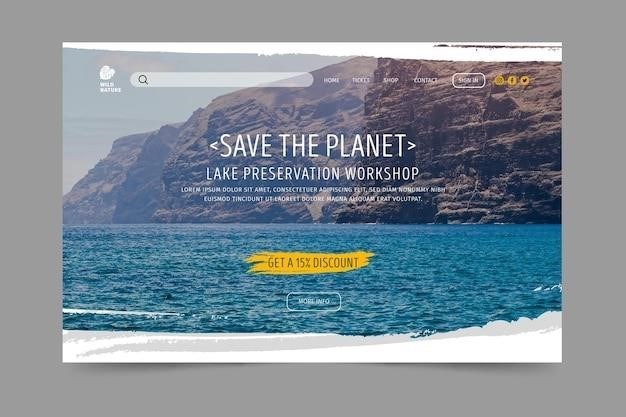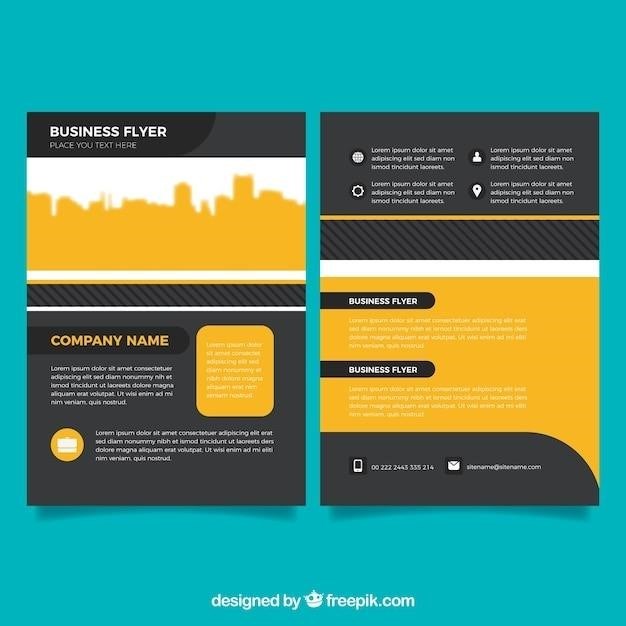
Landscape Proposal Sample PDF⁚ A Comprehensive Guide
This guide explores creating effective landscape proposals using PDF templates. Learn how to structure a winning proposal, including design details, cost breakdowns, timelines, and client communication strategies. Discover free and paid template options and legal considerations for your business.
Understanding Landscape Proposals
A landscape proposal serves as a formal document outlining the scope of a landscaping project, detailing the services offered, materials required, and associated costs. It’s a crucial tool for securing contracts, setting clear expectations with clients, and avoiding future misunderstandings. A well-structured proposal builds trust by showcasing your professionalism and expertise. It’s more than just a price quote; it’s a comprehensive presentation of your vision and capabilities; Think of it as a marketing document that sells not only your services but also your understanding of the client’s needs. The goal is to persuade the client that you’re the best choice for the job, presenting a clear path from initial consultation to project completion. Proposals should be tailored to each individual client and project, ensuring a personalized approach that demonstrates your attention to detail and commitment to client satisfaction. Remember, a compelling proposal significantly increases your chances of securing the project.
Key Elements of a Winning Proposal
A winning landscape proposal goes beyond simply listing services and prices. It needs a compelling narrative that showcases your understanding of the client’s vision and how you’ll achieve it. Begin with a strong introduction that highlights your company’s expertise and relevant experience. Clearly define the project scope, specifying the services included, materials used, and any limitations. Include detailed, itemized cost breakdowns, ensuring transparency and avoiding surprises; Present a realistic timeline with clearly defined milestones, demonstrating your organizational skills. High-quality visuals, such as sketches or renderings, are essential for conveying your design ideas effectively. Address potential challenges proactively, demonstrating foresight and problem-solving abilities. Finally, end with a clear call to action, making it easy for the client to accept your proposal. Remember, professionalism in presentation, from formatting to language, significantly impacts the overall impression.
Creating a Professional Design
The visual appeal of your landscape proposal is crucial. Use high-quality images and professional-looking graphics to showcase your design skills. Avoid cluttered layouts; opt for a clean, modern aesthetic that enhances readability and emphasizes key information. Maintain consistent branding throughout the document, using your company logo, color scheme, and fonts. If including sketches or renderings, ensure they are clear, well-labeled, and accurately reflect the proposed design. Consider incorporating before-and-after visuals to illustrate the transformative potential of your work. A well-designed proposal demonstrates your attention to detail and professionalism, creating a positive first impression on potential clients. Remember, the design should complement the content, ensuring both are easy to understand and visually engaging. High-resolution images are key to showcasing the quality of your work and enhancing the overall credibility of your proposal.
Importance of Detailed Cost Breakdown
Transparency in pricing is paramount for building trust and securing client approval. A detailed cost breakdown demonstrates professionalism and avoids misunderstandings. Itemize all expenses, including materials, labor, equipment rental, permits, and any other relevant costs. Clearly specify the unit cost of materials and the hourly rate for labor. If using subcontractors, outline their costs separately. Explain any additional fees or potential expenses upfront. Avoid vague or lump-sum pricing; instead, provide a comprehensive list of individual costs. This allows clients to understand the value of each element and the overall project cost. Consider offering different pricing options or packages to cater to various budgets. A well-structured cost breakdown not only facilitates client understanding but also streamlines the payment process and minimizes potential disputes later in the project. Accurate and detailed pricing fosters confidence and increases the likelihood of project approval.
Setting Realistic Timelines
Establishing realistic timelines is crucial for project success and client satisfaction. Begin by breaking down the project into smaller, manageable tasks. Assign estimated completion times to each task, considering potential delays or unforeseen circumstances. Include buffer time for unexpected issues, such as weather delays or material shortages. Present the timeline clearly in your proposal, using a format like a Gantt chart or a simple list with start and end dates for each phase. Be transparent about any potential delays and clearly communicate them to the client. Regularly update the client on progress and any adjustments to the timeline. A well-defined timeline demonstrates your organizational skills and commitment to delivering the project on time. Avoid overpromising and underdelivering; instead, set realistic expectations from the outset. Providing a clear and achievable timeline builds trust and ensures a positive client experience throughout the project lifecycle. Remember to factor in the time needed for client approvals and communication.
Effective Communication and Client Relations
Open and consistent communication is key to building strong client relationships and ensuring project success. Begin by actively listening to the client’s needs and vision during initial consultations. Clearly articulate your understanding of their requirements throughout the proposal process. Provide regular updates on project progress, highlighting milestones achieved and addressing any concerns promptly. Maintain a professional and courteous demeanor in all communications, responding to inquiries in a timely manner. Use a variety of communication methods to suit the client’s preferences, such as email, phone calls, or in-person meetings. Be transparent about any challenges or potential delays, offering solutions and alternatives where possible. Encourage client feedback throughout the project, fostering a collaborative environment. After project completion, follow up with a thank-you note and request feedback to improve future services. Building trust and rapport through consistent, effective communication creates a positive and productive working relationship, leading to greater client satisfaction and repeat business.
Utilizing Templates for Efficiency
Landscape proposal templates offer significant time-saving advantages for professionals. Pre-designed templates provide a structured format, ensuring all essential elements are included consistently across proposals. This eliminates the need to start from scratch each time, streamlining the proposal creation process. Templates often include sections for client information, project details, design specifications, cost breakdowns, timelines, and payment terms. Using a template ensures uniformity and professionalism in your proposals, enhancing your credibility with clients. Many templates are customizable, allowing you to incorporate your company branding, logo, and unique design elements. This consistency in branding reinforces your professional image and creates a cohesive brand experience for clients. Templates also help maintain accuracy and avoid omissions. The pre-defined structure minimizes errors and ensures all necessary information is presented clearly and concisely. By leveraging templates, landscapers can focus more time on designing and executing projects rather than spending excessive time on proposal preparation.
Free and Paid Template Options
Numerous resources offer both free and paid landscape proposal templates. Free templates, readily available online, provide a basic framework, but may lack advanced features or customization options. They often serve as a good starting point for those new to proposal writing or with limited budgets. However, free templates might require more manual formatting and adjustments to match your specific branding requirements. Paid templates, on the other hand, typically offer greater flexibility and professional design elements. They often include pre-designed layouts, customizable branding options, and advanced features like automated calculations and client portals. Paid templates often come with customer support, ensuring you can resolve any technical issues or questions efficiently. The investment in a paid template can be worthwhile, considering the time saved and the enhanced professional image it projects. The choice between free and paid depends on individual needs and budget constraints. Evaluate your requirements and assess whether the additional features and support offered by paid templates justify the cost. Compare features, design quality, and customer support before making a decision.
Legal Considerations and Contracts
Before finalizing any landscape proposal, carefully consider the legal aspects to protect both you and your client. Ensure your proposal clearly outlines the scope of work, payment terms, and project timelines to prevent misunderstandings. Include a detailed description of the services provided, specifying materials, labor, and any additional costs. Clearly define payment schedules, including deadlines and methods of payment, and address potential late payment consequences. Consider adding clauses about liability, insurance coverage, and dispute resolution mechanisms. A well-defined contract is crucial for managing expectations and resolving conflicts. It’s advisable to consult with a legal professional to review your contract and ensure it complies with all relevant laws and regulations in your area. This will help avoid potential legal issues down the line. Remember that a legally sound contract protects both parties involved in the project and promotes a smooth and successful collaboration. Don’t underestimate the importance of legal clarity; a well-drafted contract can be the difference between a positive outcome and costly disputes.

Showcase Expertise and Attention to Detail
A compelling landscape proposal isn’t just about presenting a design; it’s about showcasing your expertise and meticulous attention to detail. Clients want assurance that they’re hiring a professional who understands their needs and can execute the project flawlessly. Highlight your qualifications, experience, and past successes. Include testimonials or case studies that demonstrate your ability to deliver exceptional results. Use high-quality images and detailed descriptions to illustrate your design concepts. Showcase your understanding of plant selection, hardscaping techniques, and overall landscape design principles. Explain your design choices, justifying them with reasons based on functionality, aesthetics, and sustainability. Address potential challenges and how you plan to overcome them, demonstrating your proactive approach and problem-solving skills. By presenting a comprehensive and well-thought-out proposal that showcases your expertise, you’ll build client confidence and increase your chances of winning the project. Attention to detail in your proposal reflects your attention to detail in your work, a quality highly valued by discerning clients.